Marimba
This article needs additional citations for verification. (August 2018) |
 Classical marimba, model Antonko AMC-12 | |
| Percussion instrument | |
|---|---|
| Classification | Percussion |
| Hornbostel–Sachs classification | 111.212 (Concussive idiophone or set of percussion sticks whose sound is generated by way of being struck by a mallet) |
| Developed | Mexico in the late 19th century (modern marimba) |
| Playing range | |
 | |
| Related instruments | |
| marimbaphone, xylophone | |
| Musicians | |
| See list of marimbists | |
| Builders | |
| See list of marimba manufacturers | |
The marimba (/məˈrɪmbə/) is a percussion instrument consisting of a set of wooden bars struck with yarn or rubber mallets to produce musical tones. Resonators or pipes are suspended underneath the bars to amplify their sound. The bars of a chromatic marimba are arranged like the keys of a piano, with the groups of two and three accidentals raised vertically, overlapping the natural bars to aid the performer both visually and physically. This instrument is a type of idiophone, but with a more resonant and lower-pitched tessitura than the xylophone. A person who plays the marimba is called a marimbist or a marimba player.
Modern uses of the marimba include solo performances, woodwind and brass ensembles, marimba concertos, jazz ensembles, marching band (front ensembles), drum and bugle corps, indoor percussion ensembles, and orchestral compositions.
Etymology[]

The name marimba is akin to Kimbundu and Kikongo marimba or malimba, with the Bantu prefix ma- 'many' and Bantu -rimba 'single-bar xylophone'.[1] Its first reported use in the English language has been documented as far back as 1704.[2]
History[]
Ancient[]
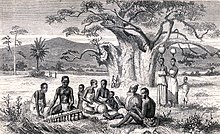
Music instruments like the Marimba are present through the entirety of Sub-Saharan Africa.[3] The instrument itself is most similar and shares its name with the marimbas of modern-day Angola and the Democratic Republic of the Congo.[4][5] Although it is also similar to instruments that exist in West Africa such as the balafon or heri of Mali and Guinea, known as gyil among the Gur peoples in and around northern Ghana and Burkina Faso.[6]
Central America[]

The Marimba is popular throughout Central America, with it's popularity spreading from southern Mexico to Nicaragua.[7] The first historical account in Central America is from 1550 where African slaves in Guatamala are reported playing it.[8][9] By 1680 accounts of Mayan musicians using marimbas with gourd resonator were made in Guatemala. It became more widespread during the 18th and 19th centuries, as Mayan and Ladino ensembles started using it on festivals. In 1821, the marimba was proclaimed the national instrument of Guatemala in its independence proclamation.[10][11]
South America[]
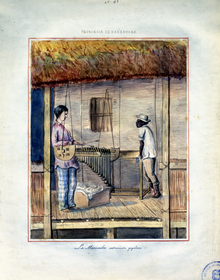
Marimba's secound range of popularity in Latin America is in the Pacific coast of Colombia and Ecuador.[12] The instruments were brought there via the African diaspora and their cultural significants has survived to the present day.[13] The Afro-Latino communities that take part in preserving and playing it value it's importance as a touchstone of their resilience.[14]
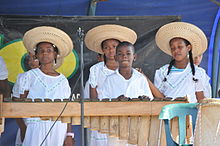
In Colombia the most widespread marimba is the marimba de chonta (peach-palm marimba). Marimba music has been listed on UNESCO as an intangible part of Colombian culture.[15] In recent times Marimberos (marimba players) and the marimba genres as a whole have started to fade out in popularity.[16] Nonetheless the genre is still popular in the departments of Chocó and Cauca.[17]
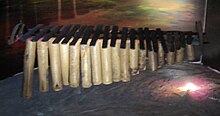
In Ecuador the most widespread marimba is the marimba esmeraldeña (Esmeralda marimba). Marimbas are an important aspect of Afro-Ecuadorian culture: many religious ceremonies and songs are accompanied with marimba music along with festivals and dances.[18] It is most popular in the province of Esmeraldas where in the 16th century Alonso de Illescas, a maroon, found a maroon settlement near the area around modern day Esmeraldas. There in that province it envokes a sense of pride for the community in which years centuries marimba music has been prohibited after government encroachment upon the Esmeraldas province.[19]
Modern[]

Marimbas have become widely popular around the world being used throughout Africa, South East Asia, Europe, North America, South America and Central America.[20]
In 1850, Mexican marimbist Manuel Bolán Cruz (1810-1863), modified the old bow marimba, by the wooden straight one, lengthening the legs so that the musicians could play in a standing mode, expanded the keyboard and replaced the gourd resonators by wooden boxes.
In 1892, Mexican musician expanded marimba to include the chromatic scale by adding another row of sound bars, akin to black keys on the piano.[21]
The name marimba was later applied to the orchestra instrument inspired by the Latin American model. In the United States, companies like J.C. Deagan and the Leedy Manufacturing Company company adapted the Latin American instruments for use in western music. Metal tubes were used as resonators, fine-tuned by rotating metal discs at the bottom; lowest note tubes were U-shaped. The marimbas were first used for light music and dance, such as vaudeville theater and comedy shows.[22] Clair Omar Musser was a chief proponent of marimba in the United States at the time.
French composer Darius Milhaud introduced marimbas into Western classical music with his 1947 Concerto for Marimba and Vibraphone. Four-mallet grip was employed to play chords, enhancing interest for the instrument.[22] In the late 20th century, modernist and contemporary composers found new ways to use marimba: notable examples include Leoš Janáček (Jenufa), Carl Orff (Antigonae), Karl Amadeus Hartmann, Hans Werner Henze (Elegy for Young Lovers), Pierre Boulez (Le marteau sans maître) and Steve Reich.
Construction[]

Bars[]
Marimba bars are typically made of either wood or synthetic material. Rosewood is the most desirable, while Padauk is a popular affordable alternative. Bars made from synthetic materials generally fall short in sound quality in comparison to wooden bars, but are less expensive and yield added durability and weather resistance,[23] making them suitable for outdoor use; marimbas with wooden bars are usually played inside because the bars are susceptible to pitch change due to weather. Bubinga (Guibourtia demeusei) and mahogany have also been cited as comparable to rosewood in quality for use as marimba bars.[24] The specific rosewood, Dalbergia stevensonii, only grows in Southern Guatemala and Belize, formerly the British Honduras.[25] This wood has a Janka rating of 2200, which is about three times harder than Silver Maple. The bars are wider and longer at the lowest pitched notes, and gradually get narrower and shorter as the notes get higher. During the tuning, wood is taken from the middle underside of the bar to lower the pitch. Because of this, the bars are also thinner in the lowest pitch register and thicker in the highest pitch register.
In Africa, most marimbas are made by local artisans from locally available materials.
Marimba bars produce their fullest sound when struck just off center, while striking the bar in the center produces a more articulate tone. On chromatic marimbas, the accidentals (black keys) can also be played on the extreme front edge of the bar, away from the node (the place where the string goes through the bar) if necessary. Playing on the node produces a sonically weak tone, and the technique is only used when the player or composer is looking for a muted sound from the instrument.


Range[]
There is no standard range of the marimba, but the most common ranges are 4.3 octaves, 4.5 octaves and 5 octaves; 4, 4.6 and 5.5 octave sizes are also available.
- 4 octave: C3 to C7.
- 4.3 octave: A2 to C7. The .3 refers to three semitones below the 4 octave instrument. This is the most common range.
- 4.5 octave: F2 to C7. The .5 means "half";
- 4.6 octave: E2 to C7, one semitone below the 4.5. Useful for playing guitar literature and transcriptions.
- 5 octave: C2 to C7, one full octave below the 4 octave instrument, useful for playing cello transcriptions, e.g., J. S. Bach's cello suites.
- Bass range (varies, but examples range from G1–G3 or C2–F3)
The range of the marimba has been gradually expanding, with companies like Marimba One adding notes up to F above the normal high C (C7) on their 5.5 octave instrument and marimba tuners adding notes lower than the low C on the 5 octave C2. Adding lower notes is somewhat impractical; as the bars become bigger and the resonators become longer, the instrument must be taller and the mallets must be softer in order to produce a tone rather than just a percussive attack. Adding higher notes is also impractical because the hardness of the mallets required to produce the characteristic tone of a marimba are much too hard to play with in almost any other, lower range on the instrument.
The marimba is a non-transposing instrument with no octave displacement, unlike the xylophone which sounds one octave higher than written and the glockenspiel which sounds two octaves higher than written.

Resonators[]
Part of the key to the marimba's rich sound is its resonators. These are tubes (usually aluminum) that hang below each bar.
In the most traditional versions, various sizes of natural gourds are attached below the keys to act as resonators; in more sophisticated versions carved wooden resonators are substituted, allowing for more precise tuning of pitch. In Central America and Mexico, a hole is often carved into the bottom of each resonator and then covered with a delicate membrane taken from the intestine of a pig to add a characteristic "buzzing" or "rattling" sound known as charleo.[26] In more contemporary-style marimbas, wood is replaced by PVC tubing. The holes in the bottoms of the tubes are covered with a thin layer of paper to produce the buzzing noise.
The length of the resonators varies according to the frequency that the bar produces. Vibrations from the bars resonate as they pass through the tubes, which amplify the tone in a manner very similar to the way in which the body of a guitar or cello would. In instruments exceeding 4+1⁄2 octaves, the length of tubing required for the bass notes exceeds the height of the instrument. Some manufacturers, such as and , compensate for this by bending the ends of the tubes. This involves soldering smaller straight sections of tubes to form "curved" tubes. Both DeMorrow and Malletech use brass rather than aluminium. Others, such as Adams and Yamaha, expand the tubes into large box-shaped bottoms, resulting in the necessary amount of resonating space without having to extend the tubes. This result is achieved by the custom manufacturer Marimba One by widening the resonators into an oval shape, with the lowest ones reaching nearly a foot in width, and doubling the tube up inside the lowest resonators—a process known as "Haskelling", originally used in pipe organ resonators, and named for its inventor, William E. Haskell.
Resonator tuning involves adjusting "stops" in the tubes themselves to compensate for temperature and humidity conditions in the room where the instrument is stored. Some companies offer adjustment in the upper octaves only. Others do not have any adjustable stops. Still some companies (Malletech and DeMorrow) offer full range adjustable stops.
On many marimbas, decorative resonators are added to fill the gaps in the accidental resonator bank. In addition to this, the resonator lengths are sometimes altered to form a decorative arch, such as in the Musser M-250. This does not affect the resonant properties, because the end plugs in the resonators are still placed at their respective lengths.
Mallets[]

The mallet shaft is commonly made of wood, usually birch, but may also be rattan or fiberglass. The most common diameter of the shaft is around 8 mm (1⁄4 in). Shafts made of rattan have a certain elasticity to them, while birch has almost no give. Professionals use both depending on their preferences, whether they are playing with two mallets or more, and which grip they use if they are using a four-mallet grip.
Appropriate mallets for the instrument depend on the range. The material at the end of the shaft is almost always a type of rubber, usually wrapped with yarn. Softer mallets are used at the lowest notes, and harder mallets are used at the highest notes. Mallets that are too hard will damage the instrument, and mallets that might be appropriate for the upper range could damage the notes in the lower range (especially on a padouk or rosewood instrument). On the lower notes, the bars are larger, and require a softer mallet to bring out a strong fundamental. Because of the need to use varying hardnesses of mallets, some players, when playing with four or more mallets, might use graduated mallets to match the bars that they are playing (softer on the left, harder on the right).
Some mallets, called "two-toned" or "multi-tonal", have a hard core, loosely wrapped with yarn. These are designed to sound articulate when playing at a loud dynamic, and broader at the quieter dynamics.
Mallet technique[]
Modern marimba music calls for simultaneous use of between two and four mallets (sometimes up to six or eight),[27] granting the performer the ability to play chords or music with large interval skips more easily. Multiple mallets are held in the same hand using any of a number of techniques or grips. For two mallets in each hand, the most common grips are the Burton grip (made popular by Gary Burton), the Traditional Grip (or "cross grip") and the Musser-Stevens grip (made popular by Leigh Howard Stevens). Each grip is perceived to have its own benefits and drawbacks. For example, some marimbists feel the Musser-Stevens grip is more suitable for quick interval changes and mallet independence, while the Burton grip is more suitable for stronger playing or switching between chords and single-note melody lines. The Traditional Grip gives a greater dynamic range and freedom of playing. The choice of grip varies by region (the Musser-Stevens grip and the Burton grip are more popular in the United States, while the traditional grip is more popular in Japan), by instrument (the Burton grip is less likely to be used on marimba than on a vibraphone) and by the preference of the individual performer.
Six-mallet grips consist of variations on these three grips. Six mallet marimba grips have been used for years by Mexican and Central American marimbists, but they are generally considered non-standard in the Western classical canon. Keiko Abe has written a number of compositions for six mallets, including a section in her concerto Prism Rhapsody. Other marimbists/composers using this technique include Rebecca Kite (who commissioned composer Evan Hause to write Circe, a major work for six mallets, in 2001), Dean Gronemeier, Robert Paterson, and Kai Stensgaard. Paterson's grip is based on the Burton grip, and his grip and technique have been called the Paterson grip, and even the Wolverine grip. Paterson states that his technique differs from others in that there is less emphasis places on block chords on the lower bank of notes (the naturals or white notes) and more emphasis on independence, one-handed rolls, and alternations between mallets 12-3 or 1-23 in the left hand (or 45-6 or 4-56 in the right hand, respectively), and so on. In 2012, Paterson released the world's first all six-mallet marimba album entitled Six Mallet Marimba, demonstrating these techniques via works Paterson has written. Kai Stensgaards grip is based on the Stevens Grip describes in the method: The Six Mallet Grip. He has written a number of compositions for six mallets, among those Concierto Mexicano for marimba & Orchestra. He started playing this grip in 1985. Ludwig Albert published at first a work for 8 mallets and demonstrated the Ludwig Albert 8 mallet grip based on the traditional grip from 1995.
Classical works[]
This article needs additional citations for verification. (June 2015) |
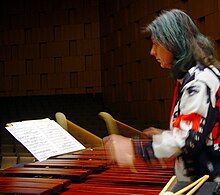
This list represents an incomplete selection of Western classical compositions for the instrument:
- Keiko Abe: Dream of the Cherry Blossoms (1983), Frogs (1958), Michi (1978), Variations on Japanese Children's Songs (1982), Prism for Solo Marimba (1986)[28]
- Bruce Adolphe: Self Comes to Mind (2009), Red Dogs and Pink Skies (2002), Reach Out, Raise Hope, Change Society (2011)
- Benjamin C.S. Boyle: Les bois du paradis (2012)
- Stephen Brown: Shadow of a Leaf, soprano and marimba (2006), a ten-song cycle sung as one
- Howard J. Buss: A Day in the City (1986) – Brixton Publications
- Howard J. Buss: Rite of Passage (1995) Brixton Publications
- Howard J. Buss: Concerto for Marimba and Percussion Ensemble (2018) Brixton Publications
- Paul Creston: Concertino for Marimba (1940)
- Emma Lou Diemer: Concerto in One Movement for Marimba and Chamber Orchestra (1991)
- Jacob Druckman: Reflections on the Nature of Water (1986) commissioned by William Moersch, Leigh Howard Stevens, and Gordon Stout[29]
- Aisha Duo: Quiet Songs (2005)
- Safri Duo: Baya Baya
- Robert Greenberg: In Shape: Concerto in Three Movements for Two Pianos and Marimba (1991) Fallen Leaf Press
- Joseph Hallman: Violencia for marimba and cello (2007), written for Alisa Weilerstein and Matthew McClung.
- John Harbison: Concerto for Bass Viol (2005)
- Hans Werner Henze: Five Scenes from the Snow Country for Marimba solo (1978) commissioned by Michiko Takahashi
- David A. Jaffe: The Library of Babel, for two five-octave marimbas (2012)
- Anders Koppel: Marimba Concertos 1–4 (1995–2005), Tarantella' (for violin and marimba) (2001), Toccata (for marimba and vibraphone) (1990)
- Frederik Magle: Cantabile (symphonic suite) – The Cortège & Danse Macabre movement includes a marimba solo[30] (2009)
- Linda Maxey: The Artistry of the Marimba (1994)
- Olivier Messiaen: La Transfiguration de Notre Seigneur Jésus-Christ ("The Transfiguration of Our Lord Jesus Christ"), large 10-part chorus, piano solo, cello solo, flute solo, clarinet solo, xylorimba solo, vibraphone solo, large orchestra (1965–69)
- Olivier Messiaen: Saint-François d'Assise (Saint Francis of Assisi, opera)
- Darius Milhaud: Concerto for Marimba, Vibraphone and Orchestra, Op. 278 (1947)
- Luigi Morleo: Concerto per Marimba e Archi (1993)
- Thea Musgrave: Journey through a Japanese Landscape (1994)
- Clair Omar Musser: Etude in C Major
- Lior Navok: Rosewood Staircase (2000)
- Robert Paterson: Komodo (2005), Piranha (2009) (both using six-mallets), Mandala (for two marimbas) (2012) (four-mallets), Forest Shadows, numerous works for marimba and other instruments
- Mitchell Peters: Yellow After the Rain (1971), Sea Refractions
- Tarik O'Regan: Triptych (2005) originally for choir and strings, later arranged for choir and marimbas
- Steve Reich: Music for 18 Musicians (1976), Six Marimbas (1986), Nagoya Marimbas (for two marimbas) (1994)
- Richard Rodney Bennett After Syrinx II (1984), Concerto for Marimba and Orchestra (1988) commissioned by William Moersch
- : Concerto For Marimba and Orchestra (1986), Concerto No. 2 for Marimba and Orchestra (2001), numerous solo works
- Joseph Schwantner: Velocities (1990) commissioned by William Moersch, Leigh Howard Stevens, and Gordon Stout[29]
- Emmanuel Séjourné: Concerto for marimba and strings (2006), Concerto for Marimba Quartet "Gotan"
- Adam Silverman: Carbon Paper and Nitrogen Ink concerto for marimba and wind ensemble or percussion ensemble (2013)
- Gordon Stout: Two Mexican Dances (1974)
- William Susman: Amores Montuños (2008) for flute and marimba, Marimba Montuño (2002) for solo marimba
- Tomas Svoboda: Concerto For Marimba and Orchestra, Op. 148 (1995)
- Josef Tal: Chamber Music (1982) for Recorder, Marimba and Harpsichord
- Andrew Thomas: Merlin (1985) for solo marimba commissioned by William Moersch[31]
- Augusta Read Thomas: Silhouettes (2004)
- Peter Togni: Lux Aeterna (2010) – Gamelan & six voices, later arranged for SATB and marimbas
- Andersen Viana: Grlashodibzntmev for Vibraphone and Marimba (2006), 3 Fugues (2010)
- Alejandro Viñao: Khan Variations (2001), Burritt Variations (2012), Book of Grooves (for two marimbas) (2011)
- Charles Wuorinen: Percussion Symphony (1976), Percussion Quartet (1994), Metagong (2008), Marimba Variations for five-octave marimba (2009)
- Takashi Yoshimatsu: Marimba Concerto "Bird Rhythmics" (2010)
- Alfred Reed: Concertino for Marimba and Winds (1993)
In other music[]

Traditional marimba bands are especially popular in Guatemala, where they are the national symbol of culture, but are also strongly established in the Mexican states of Chiapas, Tabasco, and Oaxaca. They are also very popular in other Central American nations such as Honduras, El Salvador, Nicaragua, and Costa Rica, as well as among Afro-Ecuadorians and Afro-Colombians.
There have been numerous jazz vibraphonists who also played the marimba. Notable among them are Gary Burton, David Friedman, Stefon Harris, Bobby Hutcherson, Joe Locke, Steve Nelson, Red Norvo, Dave Pike, Gloria Parker, Dave Samuels, and Arthur Lipner.
Marimbist and vibraphonist Julius Wechter was the leader of a popular 1960s Latin-flavored band called Baja Marimba Band. Herb Alpert and his Tijuana Brass made frequent use of the marimba.
Brian Jones played a marimba in the Rolling Stones' songs "Under My Thumb" and "Out of Time". "Island Girl" by Elton John and "Moonlight Feels Right" by Starbuck also prominently feature the instrument. Ruth Underwood played an electrically amplified marimba in Frank Zappa's The Mothers of Invention. Art Tripp played the marimba on several of Captain Beefheart & the Magic Band's albums, most notably on Lick My Decals Off, Baby and The Spotlight Kid. Victor Feldman played a marimba on several of Steely Dan's early albums. It is played at the start of "Mamma Mia" by ABBA[32] and also played by Mike Mainieri in the Dire Straits track "Private Investigations".
"Vincent" by Don McLean features a marimba. "Shape of You" by Ed Sheeran includes a marimba as part of the tropical house effects. The Psychedelic Furs 1982 song "Love My Way" features a marimba, originally played by Todd Rundgren, throughout. It is also featured on Toto's 1982 hit song "Africa". Percussionist Evelyn Glennie has collaborated with Björk and can be heard playing a marimba on Post and Telegram, as well as Oxygen. Thompson Twins included a marimba in their many 1980s works. Jack White played marimba on "The Nurse", a song on the White Stripes' album Get Behind Me Satan. In 2003, Marina Calzado Linage recorded an album bridging the gap between academic and popular music, Marimba de Buenos Aires, featuring music by Astor Piazzolla. In 2009, Canadian musician Spencer Krug, working under the moniker Moonface, released a 20-minute continuous piece called Dreamland EP: Marimba And Shit-Drums with Jagjaguwar. The recording consists entirely of marimba, drums, and vocals and comprises many movements and recurring themes. Vincent Montana Jr. played the marimba on the 1970s song "People Make the World Go Round" by the Stylistics. The experimental band Coil used the marimba in its later performances such as Selvaggina, Go Back into the Woods and studio albums The Ape of Naples and Black Antlers. The song "Sweet Emotion" by Aerosmith features bass marimba as well, played by recording engineer Jay Messina.
The marimba sound has also become recognizable through its role as the default ringtone in Apple's iOS mobile operating system.
Flapamba[]
 Flapamba (from Emil Richards Collection) | |
| Classification | Percussion instrument (Idiophone) |
|---|---|
| Developed | Brent Seawell |
| Playing range | |
| F2–C4, C4–C6 | |
| Builders | |
| Chris Banta | |
The flapamba is a musical instrument in the percussion family. It consists of tuned wooden bars pinched on one side (over the node), and mounted over resonator boxes. Sliding the bars slightly forward or backward affects their tuning. Unlike marimba or xylophone however, the sound is not as focused tonally, as it is a bit more percussive (closer to tuned log drums).
Part of what makes the flapamba's characteristic sound is the tuning; for instance, the resonators are not tuned to the bars as in other standard keyboard percussion instruments. Renowned studio percussionist Emil Richards bought his original flapamba from Professional Drum Shop in Hollywood in the late 1960s or early 1970s, and added it to his giant instrument collection, the Emil Richards Collection.[33] The staff at the store convinced him to buy it, as they told him that they were getting out of the percussion rental business since Emil was dominating much of the work in town. Emil couldn't find any info on the history or maker of the flapamba when he purchased it, but nevertheless he started using it on recording sessions, as the chromatic layout of the instrument made it an easy transition from other keyboard mallet instruments. He used the softest mallets possible or the meat of the fingers to get a warm, resonant, wooden sound.[34] This original flapamba had a range from middle C (C4), up two full octaves.
In the 2000s, Emil decided that he would like the flapamba to have an additional lower range, so specialty mallet craftsman Chris Banta made new bars spanning F2 to C4, and dubbed this the "bass flapamba". He also replaced the bars on the original set to maintain continuity of sound between both sets, and changed the finish to a blonde color from the original set's brown. Both sets combined have a range from F2–C6. Emil's flapamba has been heard on countless soundtracks and other recordings, such as on the television shows Lost, Daktari, and Kung Fu.[34]
Elmer Bernstein used it on his soundtrack for McQ.[35]
The beginning of the Steely Dan track Rikki Don't Lose That Number features Victor Feldman playing the flapamba, but his contribution was cut from the original ABC single version.[36]
See also[]
- List of marimba manufacturers
- List of marimbists
- Quadrangularis Reversum
References[]
- ^ "marimba | Origin and meaning of marimba by Online Etymology Dictionary". www.etymonline.com. Retrieved 2021-08-29.
- ^ "Definition of MARIMBA". www.merriam-webster.com. Retrieved 2021-08-29.
- ^ "The origins of the Marimba:The birth of the marimba - Musical Instrument Guide - Yamaha Corporation". www.yamaha.com. Retrieved 2021-08-29.
- ^ Nelo, Manuel Neto Matos Osório; Assunção Soares, Armando; Catarino, Paula (2017). "Etnomatemática da Marimba: instrumento etnográfico da provincia de Malanje em Angola". Revista Latinoamericana de Etnomatemática (in Portuguese). 10 (1): 6–20.
- ^ "History - Vienna Symphonic Library". www.vsl.co.at. Retrieved 2021-08-29.
- ^ Jessup, Lynne (1983). The Mandinka Balafon: An Introduction with Notation for Teaching. Art Path Press. ISBN 978-0-916421-04-5.
- ^ "The marimbas popularity throughout Central America".
- ^ "African origins of the marimba in Guatamala". Retrieved 2021-08-29.
- ^ "The marimba, Guatamala's national instrument and it's origins".
- ^ "The Marimbas of Guatemala". The Concise Garland Encyclopedia of World Music. 11 January 2013. p. 241. ISBN 9781136095702.
- ^ Rager, Daniel (2008). "The History of the Marimba".
- ^ "UNESCO - Marimba music, traditional chants and dances from the Colombia South Pacific region and Esmeraldas Province of Ecuador". ich.unesco.org. Retrieved 2021-08-29.
- ^ Kraul, Chris; Nov. 30, Los Angeles Times; Pt, 2010 12 Am (2010-11-30). "Colombia works to keep marimba traditions alive". Los Angeles Times. Retrieved 2021-08-29.
- ^ "Rio Mira's 'Román Román' Tells A People's History Through The Marimba". NPR.org. Retrieved 2021-08-29.
- ^ "Marimba UNESCO". colombiareports.com. Retrieved 2021-08-29.
- ^ Kraul, Chris; Nov. 30, Los Angeles Times; Pt, 2010 12 Am (2010-11-30). "Colombia works to keep marimba traditions alive". Los Angeles Times. Retrieved 2021-08-29.
- ^ "Smithsonian Center for Folklife and Cultural Heritage". folklife.si.edu. Retrieved 2021-08-29.
- ^ "Marimba, importance in Ecuador". www.ecuador.com.
- ^ "Marimba origin Ecuador". www.orijinculture.com. Retrieved 2021-08-29.
- ^ "Marimba | musical instrument". Encyclopedia Britannica. Retrieved 2021-08-29.
- ^ "La marimba, madera que también cambia". Noticiasnet.
- ^ Jump up to: a b "Marimba > History". Vienna Symphonic Orchestra.
- ^ "Marimba Bars". Retrieved 16 July 2011.
- ^ "Making the Bars". Crafty Music Teachers. Archived from the original on 2 September 2011. Retrieved 16 July 2011.
- ^ Moore, James (1978). Acoustics of Bar Percussion Instruments. Columbus, Ohio: Perums Publications. p. 17.
- ^ Chenowith, Vida. The Marimbas of Guatemala., quoted in Squyres, Danielle (2002-01-02). "The Marimba, Xylophone and Orchestra Bells". Mechanical Music Digest Archives. Retrieved 2006-12-06.
- ^ "Marimba from 0-8 mallets: CD and vinyl album by jane boxall ~ marimba — Kickstarter". Kickstarter.com. 2012-03-28. Retrieved 2012-11-24.
- ^ Kelsey, Chris. "Keiko Abe". Compositions. Retrieved 23 August 2021.
- ^ Jump up to: a b https://digital.library.unt.edu/ark:/67531/metadc4879/m2/1/high_res_d/dissertation.pdf
- ^ "Cantabile – A Symphonic Suite by Frederik Magle". magle.dk. Retrieved 2012-01-16.
- ^ "Merlin - TEK Percussion Database". perctek.com. Retrieved 2016-09-15.
- ^ "Mamma Mia – The Song That Saved ABBA". ABBA – The Official Site. Polar Music International. Archived from the original on 5 January 2012. Retrieved 25 September 2009.
- ^ "Emil Richards instruments". Emil Richards. Archived from the original on 17 March 2012. Retrieved 14 August 2012.
- ^ Jump up to: a b "LAPR website". LA Percussion Rentals. Retrieved 14 August 2012.
- ^ Spencer, Kristopher (2008). Film and Television Scores, 1950–1979: A Critical Survey by Genre. McFarland. p. 19. ISBN 9780786452286.
- ^ "Best Miscellaneous Steely Dan Performances". Something Else!. Retrieved 2015-03-05.
External links[]
| Wikimedia Commons has media related to Marimbas. |
- Science of the Marimba – Scientific aspects of its construction and performance
- The La Favre 5 Octave Marimba – Physics and construction with images, sounds, animations and data
- Origin of Southern African marimbas, by Andrew Tracey
- New York Times article of the marimba
- Tokyo Marimba Trio (Michiko Noguchi Official Website)
- C instruments
- Central American and Caribbean percussion instruments
- Costa Rican musical instruments
- Guatemalan musical instruments
- Keyboard percussion
- Pitched percussion
- Salvadoran musical instruments
- Stick percussion idiophones